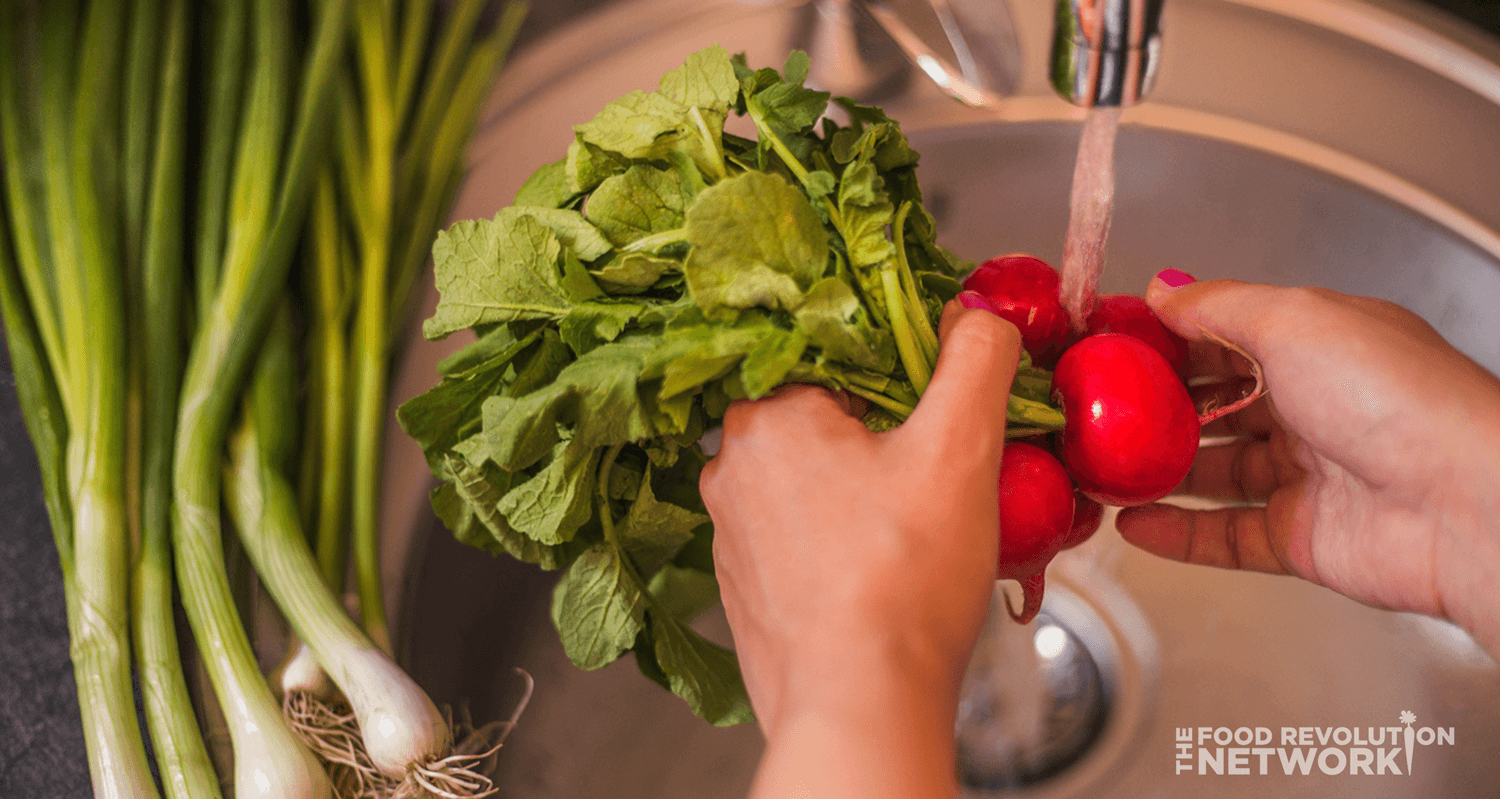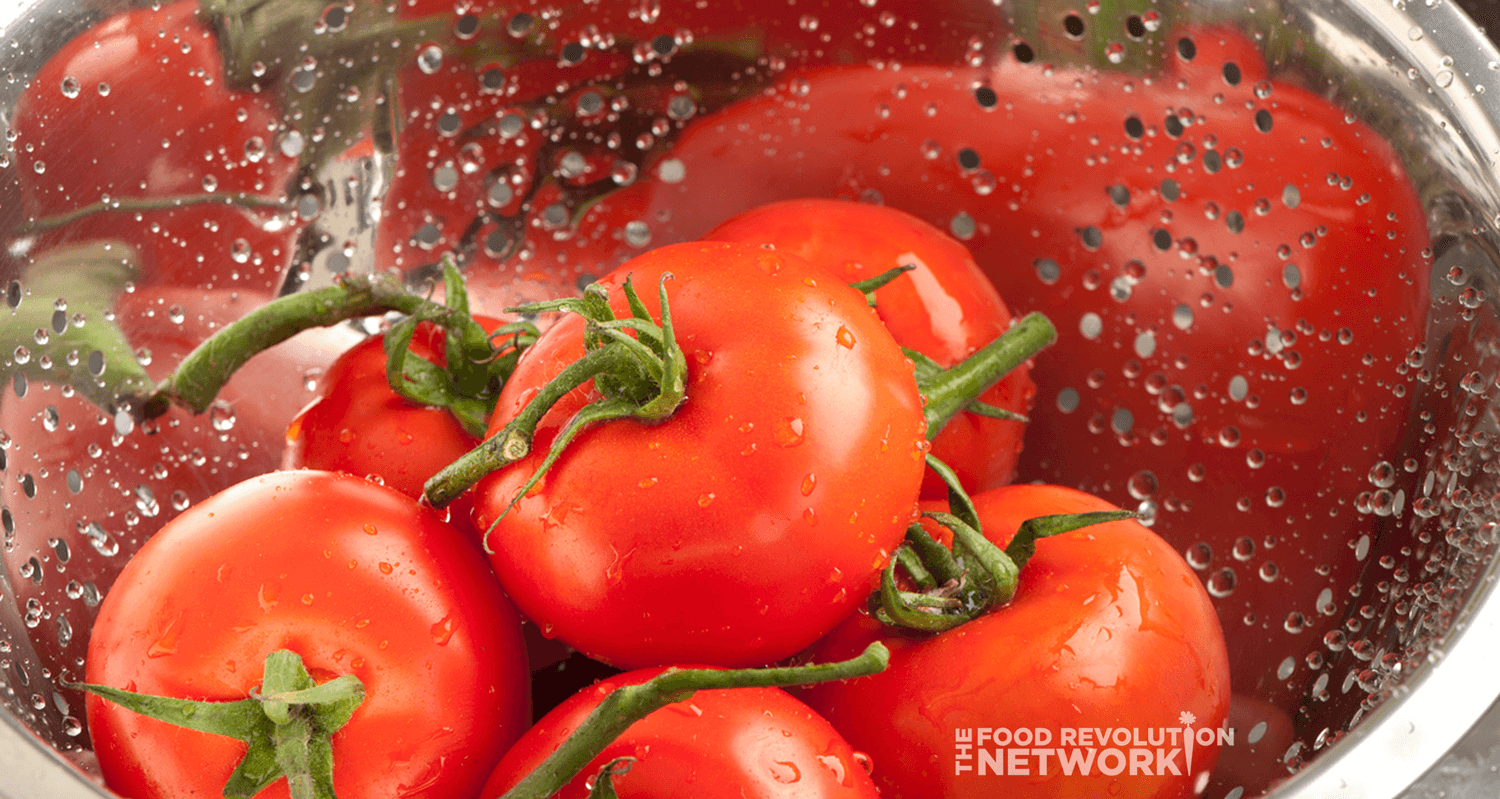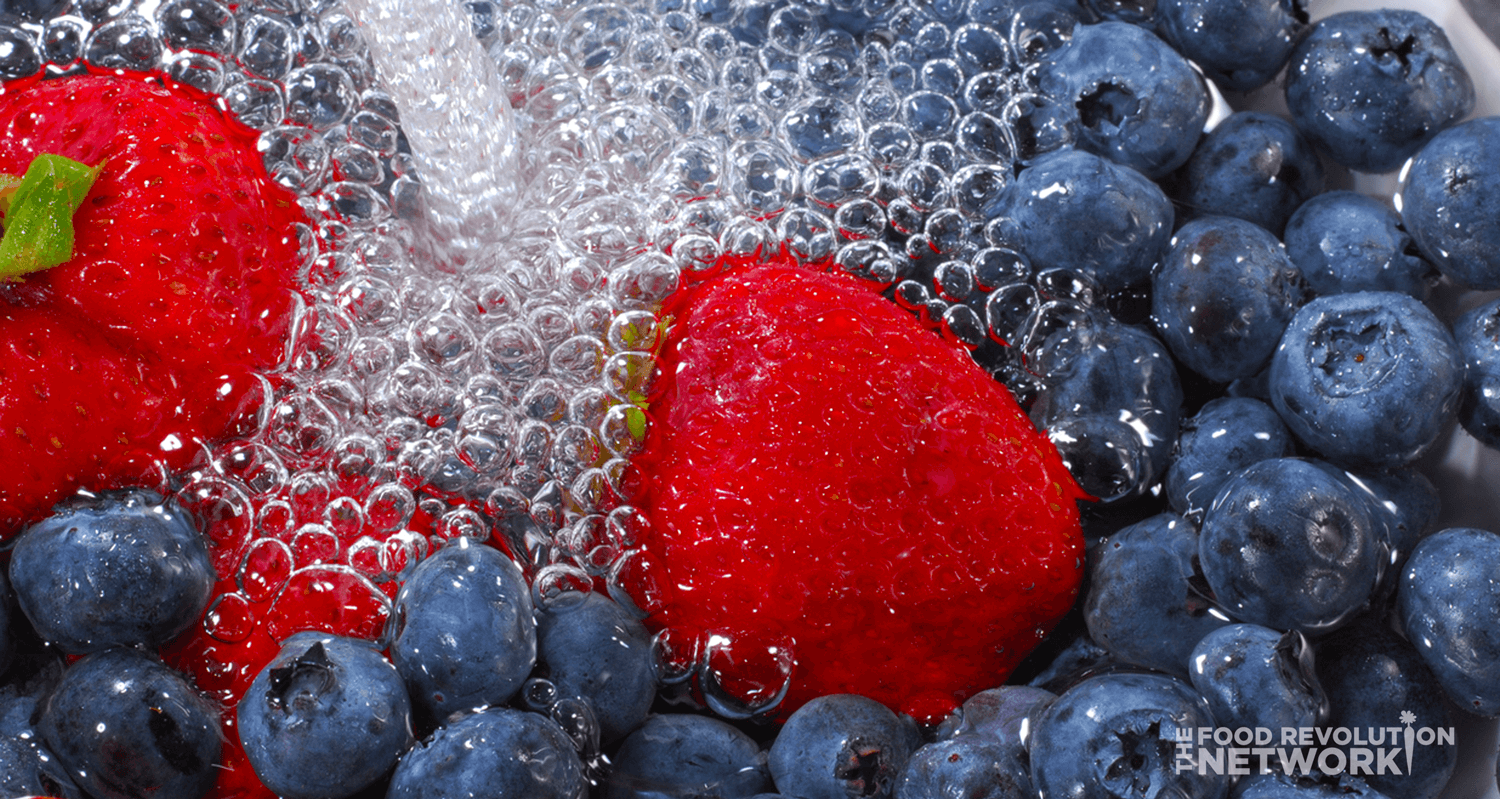Get proven tips on how to wash vegetables and how to wash fruits so you can protect your health and your family.
Almost everyone should be eating more fruits and vegetables. You know that. But do you know why it’s important to wash your produce before eating it?
In our modern world, almost no food is 100% free of pesticides. Surprisingly, even organic produce may contain some pesticide residues.
Washing produce is important to prevent foodborne illness and substantially reduce your exposure to pesticides.
To reduce your pesticide exposure, the conventional advice is to choose organic food when you can, especially for the foods most likely to be contaminated with pesticides. And then, to wash your fruits and veggies before eating or cooking with them.
But, what foods are the most important to buy organic? And what is the best way to wash your produce to remove pesticides?
Science has given us answers. And we’ll share them with you. We want to help you make the best use of your time and money and to ensure the food you eat and serve is as safe as possible.
First, we’ll explain why pesticides are used on produce, why organic produce has pesticides, and what foods are most important and least important to buy organic.
Why Are Pesticides Used on Produce?
According to the EPA, pesticides are used to control pests and disease-carriers, such as mosquitoes, ticks, rats, and mice. They are also used to control weeds, insect infestations, and diseases.
There are many types of pesticides, including:
- Herbicides – Glyphosate, which is manufactured by the company Monsanto and used in the production of their weed-killer, Roundup, is one type of herbicide that may be used on conventional (non-organic) crops. This common herbicide has been linked to cancer and endocrine disruption.
- Insecticides – Organophosphates are one group of insecticides commonly used on produce. Chlorpyrifos is one such organophosphate that has been in the news lately and is associated with damaging the developing brains of children.
A large body of evidence links exposure to pesticides to an elevated rate of chronic diseases including:
- Cancer and diabetes
- Neurodegenerative diseases such as Parkinson’s, Alzheimer’s, and ALS
- Birth defects and reproductive disorders
- Asthma, COPD, and more
These are very real risks for those exposed to pesticides. Many of the more severe cases often happen to agricultural workers who are exposed to pesticides on the job. This is one reason the average migrant farm worker in the U.S. is reported to live only to the age of 49.
Why Does Organic Produce Have Pesticides?
Many shoppers choose organic foods because they believe they are grown and produced without the use of pesticides. And because many pesticides are banned from organic agriculture, it is indeed a big step in the right direction.
But nearly all farmers — even organic farmers — use some pesticides. They just use different ones.
Why would organic farmers use pesticides? Like conventional farmers or anyone who has a backyard garden, organic farmers are faced with weeds, insects, and diseases.
Most of the pesticides on the USDA organic national list of allowed substances are natural in origin. Conventional farmers are allowed to use 900 different synthetic pesticides. But organic farmers are allowed to use only 25 synthetic pesticides – and then only in carefully regulated ways.
Why Choosing Organic Produce Is the Best and Safest Choice — Especially for Children and Pregnant Women
Eating organically grown foods reduces your exposure to both pesticide residue and antibiotic-resistant bacteria.
This is backed by research from Stanford University, which analyzed 17 different studies comparing the health effects of organic and conventional foods.
While choosing organic is probably the safest option for everyone, it’s especially important for pregnant women and children to avoid exposure to pesticides.
Children are at higher risk for pesticide toxicity than adults. This is because the developing brain is more susceptible to neurotoxins and the dose of pesticides per body weight is likely to be higher in children.
Children whose mothers were exposed to high levels of pesticides have been found to have lower IQs compared to children with the lowest levels of pesticide exposure.
Also, children exposed to pesticides are at an increased risk for a variety of chronic conditions, including learning and behavioral problems.
According to a study in Pediatrics, higher than median levels of pesticide residue in the urine were associated with double the odds of ADHD compared to those with undetectable levels.
The Most Important (And Least Important) Foods to Buy Organic
Maybe you can’t always choose organic produce. But you can make informed decisions about what fruits and vegetables are best to buy organic.
Here’s a helpful tool: The Environmental Working Group compiles a list every year of the most and least contaminated produce and updates it every year.
Here is their list of the most contaminated produce (most important to buy organic) known as the Dirty Dozen:
- Strawberries
- Spinach
- Nectarines
- Apples
- Grapes
- Peaches
- Cherries
- Pears
- Tomatoes
- Celery
- Sweet Bell Peppers
- Hot Peppers
And here is their list of the least contaminated produce known as the Clean Fifteen:
- Avocados
- Sweet corn (Note: could be GMO)
- Pineapples
- Cabbage
- Onions
- Sweet peas, frozen
- Papayas (Note: could be GMO)
- Asparagus
- Mangos
- Eggplant
- Honeydew Melon
- Kiwi
- Cantaloupe
- Cauliflower
- Broccoli
How to Wash Produce

Do you usually wash your produce by rinsing it under cold, running water? Most people do.
This method works well to remove some of the pesticide residues from some forms of produce.
Scientists at the Connecticut Agricultural Experiment Station found that washing produce with running water reduced the amount of pesticide residue for 9 of the 12 tested pesticides.
So, running water can work, but what about using products called “produce cleaners?” Should you use them? Research has shown that most commercial produce cleaners are no more effective than plain water.
But several liquids have been shown to be more effective than plain water. Those include salt water, vinegar water, or baking soda water. Keep reading to see how to use them effectively.
Washing Produce with Salt Water and Vinegar
Salt water is one of the easiest and most cost-effective ways to remove certain pesticides.
In a study published in Food Control, researchers washed vegetables for 20 minutes in vinegar, a salt water solution, or plain water to eliminate the residue of four common pesticides – chlorpyrifos, DDT, cypermethrin, and chlorothalonil.
They discovered that a 10% salt water solution was the most effective, and far more so than washing with plain water.
Full-strength vinegar was found to be equally as effective. But using vinegar would get quite expensive and would leave foods with an unwelcome vinegary flavor, making it less than ideal for a daily vegetable wash.
The Best Way to Wash Fruits and Vegetables
What may be the best way to clean fruits and veggies comes from a new study published in the Journal of Agricultural and Food Chemistry. This study compared the effectiveness of plain water, a Clorox bleach solution, and a baking soda and water solution.
Perhaps surprisingly, the baking soda solution was found to be most effective at removing pesticide residues both on the surface and beneath the skin of apples.
The baking soda solution used in the study was very weak — a mix of only one ounce of baking soda mixed with 100 ounces of water. And it took 12 to 15 minutes of soaking to completely remove the pesticides.
What does all this mean for you? How should you use this information to wash your produce?
How to Wash Vegetables

In the studies mentioned above, researchers cleaned produce much longer than most of us would on an ordinary day. But this should not prevent us from putting their methods to use.
Most people would never wash vegetables for longer than a couple of minutes, so we’ve adapted the results of these studies to more practical everyday use.
Admittedly, it won’t be quite as effective as study results, but it should be more effective than plain water.
Here’s a quick and easy way to wash veggies using baking soda:
For leafy greens
- Fill a salad spinner with greens, then fill with water.
- Add a teaspoon of baking soda and mix well.
- Soak your greens for a minute, swish, dump, then rinse, and spin dry.
- If you don’t have a salad spinner, you can add the greens, water, and baking soda to a bowl, let them soak, drain in a strainer, rinse, then pat leaves dry with a clean lint-free kitchen towel or paper towels.
For mushrooms
There is some debate in the culinary world about how to clean mushrooms.
Some chefs prefer to gently wipe mushrooms with a damp towel. However, to clean mushrooms thoroughly, you can gently scrub mushrooms using a mushroom brush and then rinse them quickly under running water. After that, blot the mushrooms dry with a clean kitchen towel or paper towel.
For other veggies
- Fill a large bowl with water.
- Then add a teaspoon of baking soda.
- Add the veggies.
- Soak for a minute or two.
- Scrub with a brush.
- And finally, rinse off the veggies.
How to Wash Fruits

Smooth skinned fruits, such as apples, nectarines, and cherries, can be washed in a baking soda bath the same way as veggies.
Berries can be rinsed under cold water in a mesh strainer, then gently patted dry with a clean kitchen towel or paper towels just before you intend to eat them.
Although your instinct may be to rinse off berries when you bring them home, doing so actually increases moisture and accelerates spoilage, microflora, and mold. Which is why it’s best to rinse them soon before you eat them.
What’s the Takeaway?
Try to choose organic produce as much possible, especially if you are a pregnant woman or when shopping for food for children. This is especially important for the “dirty dozen” listed above.
For practicing good food hygiene, learning how to wash produce is important, whether it’s organic or conventional. When washing your fruits and vegetables, making your own baking soda or salt solution may be the best option.
But this shouldn’t be something that causes you stress. Simply soaking your vegetables for a few minutes or rinsing your produce in running water for at least 30 seconds will help the food you eat and serve be safe.
Eating lots of fresh fruits and vegetables is one of the best things you can do for your health. But take the next step and do the best you can to clean them, knowing you’re doing something very good for yourself and your health.




















